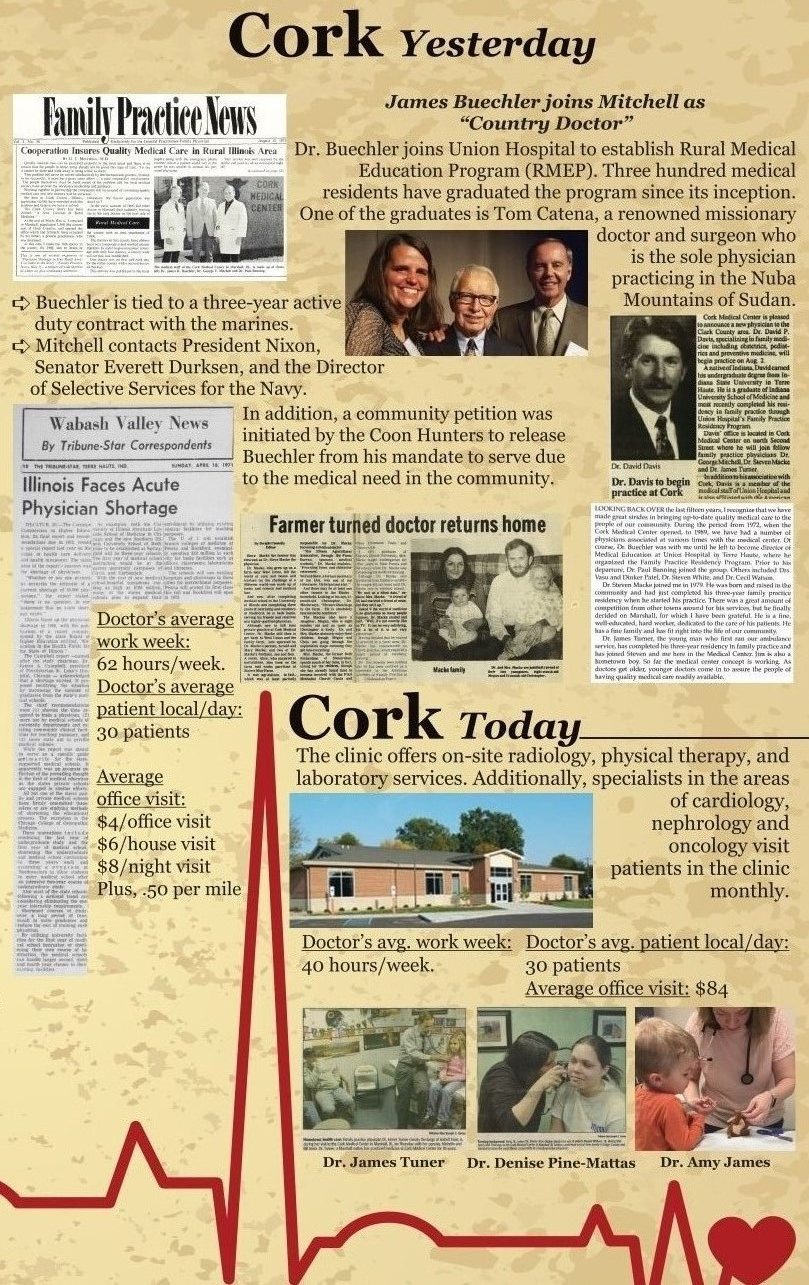Chapter 8: A New Model for Rural Medicine
Changes to rural Illinois’s physical infrastructure have sometimes precipitated or been accompanied by changes to various components of its social infrastructure, including its health-care system. The impact of one such development has been multifaceted and far reaching, as visitors to the venue that hosted Crossroads: Change in Rural America in the community where it occurred learned.
Proximity to a nationally consequential highway has also influenced the evolution of Marshall. In the late 1960s, the number of physicians serving Marshall and surrounding communities diminished to such an extent that those who remained were hard pressed to meet the needs of local residents, let alone provide emergency services when accidents occurred on US Highway 40, subsequently Interstate 70.

Recognizing that recruiting promising young doctors to serve rural communities that could not support full-scale hospitals was becoming increasingly difficult, longtime local physician George Mitchell developed an innovative concept aimed at pooling existing resources more efficiently and improving the likelihood of attracting new medical talent. Dr. Mitchell and other local civic leaders founded a clinic called Cork Medical Center in Marshall in 1971. They funded the project entirely with donations from area residents, opting not to pursue monetary support from public-sector or nonlocal sources.

The clinic enabled several general practitioners to share facilities and equipment, much of which they would have been unable to afford had each maintained a separate office. Specialists based in larger communities visited the clinic regularly, reducing the amount of traveling that residents of Marshall and Clark County had to do to receive specialized care. Cork Medical Center and a similar clinic that was established simultaneously in the small town of Casey on the other side of Clark County were among the first institutions of their kind anywhere and soon became a national model for improving access to health care in rural settings.[1]

For that reason and others, Mitchell gained national recognition as a leader in adapting to changes and challenges in rural medicine. The Illinois Academy of Family Physicians selected him as its Health Practitioner of the Year in 1993. Two years later, the National Rural Health Association named him its National Health Practitioner of the Year.[2]

Mitchell also influenced the development of education for medical students interested in serving rural communities. He contributed to the founding of the University of Illinois College of Medicine’s Rural Medical Education Program, based in Rockford, and provided training opportunities in Clark County for its participants.[3] Two other Marshall natives who became physicians and returned to their hometown to work at Cork Medical Center, Dr. Jim Buechler and Dr. James Turner, subsequently helped develop similar educational programs for prospective rural physicians in cooperation with Union Hospital in nearby Terre Haute, Indiana, and the Indiana University School of Medicine’s Terre Haute Campus.[4]
Marshall Public Library devoted a section of its Crossroads companion exhibition to the history of Cork Medical Center and its manifold contributions to the evolution of medical care in rural America. The exhibition drew extensively upon Mitchell’s remarkable memoir, Dr. George, An Account of the Life of a Country Doctor (Southern Illinois University Press, 1994), which offers insights about the evolution of many aspects of rural mid-American life, ranging from agriculture to music to politics, in addition to health care. The exhibition also incorporated content from oral-history interviews with other people affiliated with the clinic.

The library presented a program about the work of a physician whom Buechler, in his role as medical director of Union Hospital’s Richard G. Lugar Center for Rural Health, helped train: Dr. Tom Catena of Mother of Mercy Hospital in the Nuba Mountains of Sudan. The only formally trained professional physician among a population of 750,000, Catena has become known internationally for serving the people of an exceptionally poverty-stricken, war-torn region under severely arduous conditions.

The event included a screening of The Heart of Nuba, a 2016 documentary film about Catena, as well as commentary by Dr. Turner and a video message from Catena. The program emphasized that rural Americans, by drawing upon their distinctive strengths and sharing them with others, can make valuable and far-reaching contributions to humanity.[5]

- Debbie Carlson, “Historic Account Turns into Autobiography,” Journal Gazette (Mattoon, IL), February 23, 1994, C1; “Cork: Change in Rural Medical Care,” companion exhibition accompanying Crossroads: Change in Rural America, Marshall Public Library, Marshall, IL, March 23-May 4, 2019; George T. Mitchell, Dr. George: An Account of the Life of a Country Doctor (Carbondale, IL: Southern Illinois University Press, 1994), 305-344; Nancy Nixon, “Is There a Doctor in the House?: Rural Healthcare Issues in Illinois,” Illinois Country Living, March 2004, 10-13; Craig Sanders, “Clark County’s Solution: Medical Center Meets Need,” Journal Gazette (Mattoon, IL), June 17, 1978, 3; Alyson Thompson, telephone interview with author, October 16, 2019; James Turner, interview with Alyson Thompson, Friends of Marshall Public Library oral history collection, June 8, 2017, https://www.youtube.com/watch?v=2M4pQNyRxpU. ↵
- Greg Sapp, “Lake Land College Board Honors Mitchell,” Premier Broadcasting, August 11, 2015, http://thexradio.com/news/78-local-news/18169-lake-land-college-board-honors-mitchell. ↵
- “Dr. Jim Turner & Cork Medical Center Featured by Smithsonian,” Richard G. Lugar Center for Rural Health, March 16, 2019, https://www.lugarcenter.org/single-post/2019/03/16/dr-jim-turner-cork-medical-center-featured-by-smithsonian; Nancy Nixon, “Is There a Doctor in the House?”; Greg Sapp, “Lake Land College Board Honors Mitchell”. ↵
- “Dr. Jim Turner & Cork Medical Center Featured by Smithsonian,”; Sue Loughlin, “RHIC News: Terre Haute Could Become Center for Innovation, Official Says,” Tribune-Star (Terre Haute, IN), December 6, 2008, https://www.tribstar.com/news/local_news/rhic-news-terre-haute-could-become-center-for-innovation-official-says/article_0af186f2-04f7-57e3-b3a0-4d9b9bf6ea1e.html; “Lugar Center for Rural Health Founder Dr. James Buechler,” Richard G. Lugar Center for Rural Health, accessed April 1, 2023, https://www.lugarcenter.org/drb. ↵
- “Dr. Jim Turner & Cork Medical Center Featured by Smithsonian”; Alyson Thompson, telephone interview with author, October 16, 2019; Tribune-Star staff, “Rural America in Spotlight at Marshall Library: Traveling Smithsonian Exhibit to Include Local Component,” Tribune-Star (Terre Haute, IN), March 21, 2019, https://www.tribstar.com/news/local_news/rural-america-in-spotlight-at-marshall-library/article_0ebd79c3-443a-5fcc-a3f8-01cbd0d2b2c1.html. ↵



